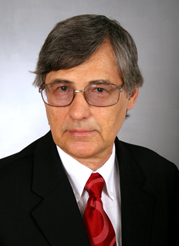

Krzysztof Szalewicz

Born January 19, 1950, Gdansk, Poland
Professor, Department of Physics and Astronomy, University of Delaware, USA
Email:szalewic@udel.edu
Web: external link
Visiting Fellow, Joint Institute for Laboratory Astrophysics, University of Colorado (1995–1996), Fellow, American Physical Society (2000), Member, Franklin Award Committee (2001–).
Author of:
About 270 scientific publications in Physics and Chemistry
Important Contributions:
Intermolecular forces: development of a new approach to intermolecular forces, known as symmetry-adapted perturbation theory (SAPT), starting from isolated monomers and imposing the correct permutation symmetry of cluster's wave function; explanation of convergence properties of SAPT; formulation and implementation of SAPT applicable to many-electron dimers as well as to pairwise nonadditive interactions; development of SAPT based on density-functional theory which extended the applicability of accurate electronic-structure methods to interactions of molecules several times larger than previously possible; formulation of dispersionless density functional; calculations of some of the most reliable intermolecular potentials to date; applications of these potentials to predict cluster spectra, collision cross sections, and bulk properties with accuracies comparable to and sometimes exceeding those of experimental data; explanation of several observations such as anomalous rotational constants in helium nanodroplets or concerning the structure of liquid water; one of the first predictions of crystal structure of organic molecules from first principles; generation of helium potentials used to create new thermophysical standards; establishment of convergence rates of many-body expansion in clusters and condensed phases.
Explicitly-correlated methods: formulation of first-quantized, explicitly correlated coupled cluster theory and pioneering applications of Gaussian-type geminals (GTG) using this method; discovery of new functionals for GTG optimization; benchmark GTG calculations for small systems including studies of molecular properties, electron-molecule scattering, and interatomic potentials.
Exotic molecules: determination of the beta-electron spectrum of molecular tritium, needed for the interpretation of neutrino mass experiments; studies of properties of muonic molecules undergoing muon-catalyzed fusion; demonstration that, contrary to earlier predictions, the measured fusion yield is at the theoretical limit; determination of density shifts and broadenings of transition lines of antiprotonic helium by helium gas relevant for tests of charge-parity-time invariance.